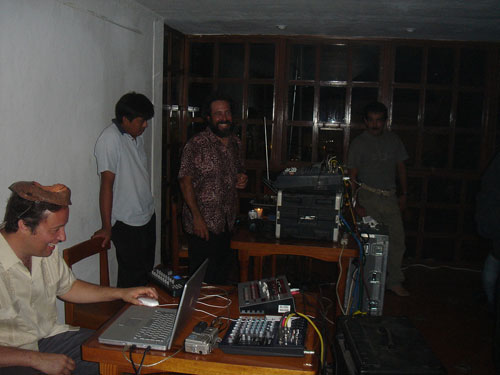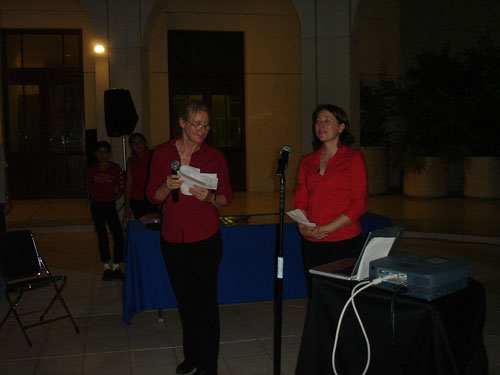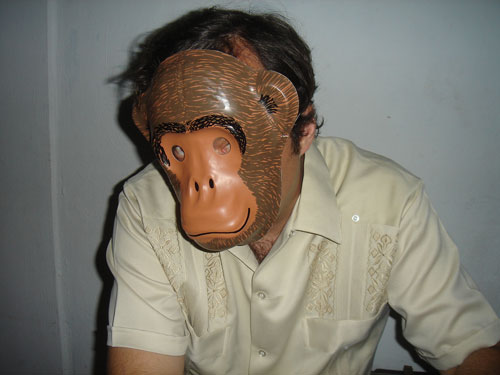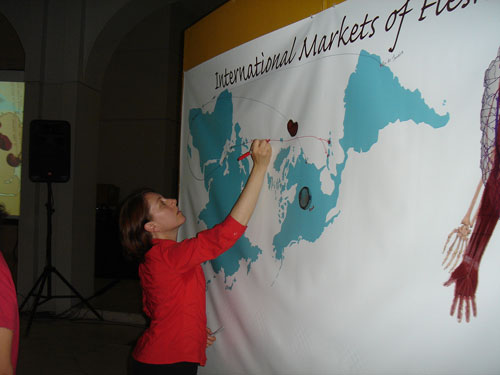 There were also video screenings throughout the week. Balanquet hosted a screening of Bulbo's video documentaries from Tijuana that focused on the everyday life of taco stand workers, rudo (rude) wrestler stars and hip hop rappers performing in Spanglish, or Spanish; these were groups which exposed the richness that makes Tijuana a city on the U.S./Mexico border, a rich place full of cultural contradictions. He also hosted a series of videos from Cuba with heavy social commentary on the state of being human as well as the role of media in defining how people relate. There was a special sound and video performance by Mr. Tamale, a collaborative consisting of Antonio Mendoza and Alberto Miyares in which I also participated. It consisted of sounds created by Miyares with samplers and a bass, while Mendoza projected remixed images ranging from hardcore porn videos to horror films like The Shining . This particular performance was four hours long. I was invited to play with them and I performed with a set of conga drums. There were also video screenings throughout the week. Balanquet hosted a screening of Bulbo's video documentaries from Tijuana that focused on the everyday life of taco stand workers, rudo (rude) wrestler stars and hip hop rappers performing in Spanglish, or Spanish; these were groups which exposed the richness that makes Tijuana a city on the U.S./Mexico border, a rich place full of cultural contradictions. He also hosted a series of videos from Cuba with heavy social commentary on the state of being human as well as the role of media in defining how people relate. There was a special sound and video performance by Mr. Tamale, a collaborative consisting of Antonio Mendoza and Alberto Miyares in which I also participated. It consisted of sounds created by Miyares with samplers and a bass, while Mendoza projected remixed images ranging from hardcore porn videos to horror films like The Shining . This particular performance was four hours long. I was invited to play with them and I performed with a set of conga drums.
 On the final night, subRosa presented an eloquent analysis on how body parts are being sold around the world. They were careful to debunk myths of the human body and familiarized the audience with the politics of body parts in the global black market. Their presentation consisted of a methodology that combines feminism and transnationality among other critical disciplines to develop new forms of criticism and resistance against the abuse of individuals, especially women. On the final night, subRosa presented an eloquent analysis on how body parts are being sold around the world. They were careful to debunk myths of the human body and familiarized the audience with the politics of body parts in the global black market. Their presentation consisted of a methodology that combines feminism and transnationality among other critical disciplines to develop new forms of criticism and resistance against the abuse of individuals, especially women.
Besides these presentations there were others I unfortunately was not able to attend. One thing that became obvious in the presentations I was able to attend is how diverse the participants were, yet how they all held together with a common bond, that of a critical position geared towards alternative forms of interpretation and presentation of work.
The biennale was well received; a local and a national newspaper reviewed the exhibit. Many of the participants, including myself, are writing or have written about it for online publications. This is a great thing because it shows how the motivations behind InteractivA--that of crossing over and creating alternative spaces and reevaluating options for working creatively--were and are actually being put into practice even as the Biennale came down.
Common themes that were brought forward over and over again during the conferencecrossing over spaces, creating alternative spaces, and questioning the establishment. In a way, these concepts are explicit in the curatorial statement in the catalog of the exhibition (available online) but the notions were even more present during the actual events. Many of the discussions that took place during and after the presentations and performances entertained the possibilities of alternatives for producing outside of a mainstream, as it can be noted in the above descriptions. And it is truly great that these activities took place in a town like Merida, a place with a rich history, which includes an unfortunate colonial period. Merida was the perfect place to have discussions on the possibilities for art in the twenty-first century; it is a place where plurality can be celebrated and embraced. After all, Mexico has experienced or is still experiencing an important period of reflection. This is true when we consider books like Guillermo Bonfil Batalla's Mexico Profundo , in which he argues that there is a denial of a major part of Mexican History; that is, the history of the Indians that lived in the Americas before the colonizers arrived, and who are still living as part of contemporary communities. He explains that by denying the History of indigenous people, Mexico is missing the opportunity to become a truly unique nation. He argues that the country is founded on an imaginary Mexico created to push it to become a "Western nation."[1] His book spurred a new way of thinking about Mexican culture. [2] Admittedly, this happened or is happening mainly in intellectual circles. In the second edition Batalla explains that the book was written in a time when "there [was] an intellectual space favorable to pluralism,"[3] and dogmatism was at a low. The book was written in the mid 1980s a time that was known as a postmodern period; a time when little narratives took the center of discourse and metanarratives became the thing to fight against. [4]
[1]Guillermo Bonfil Batalla, México Profundo (Austin, Texas: University of Texas Press, 1996), 65-66.
[2]This comment is made based on the conference "Mexico in the Nineties" which I attended at UCSD during the Spring quarter of 2005. Various intellectuals from Mexico City presented on Mexican culture and its current influence in the arts. The book was heavily mentioned.
[3]Batalla, xiii.
[4]Jean Francois Lyotard, The Postmodern Condition (Minnessota: University of Minnesota Press, 1984). This book explicitly defines the development of metanarratives and their move toward specialization which lead to little narratives. Pages 1, 2, 3, 4
|
 También hubieron presentaciones de videos durante la semana. Balanquet presentó videos de Bulbo; documentarios de Tijuana, enfocandose en la vida cotidiana de trabajadores en taquerias, estrellas de la lucha libre ruda, y raperos de hip hop quienes cantan en Spanglish or español. Estos grupos demuestran la riquesa de Tijuana debido a que está en la frontera de México y los Estados Unidos, un lugar nutrido con contradicciones culturales. Balanquet también presentó videos de Cuba, los cuales tenían comentario social sobre el estado humano y como los medios comunicativos redefinen como la gente se relaciona. Hubo una presentación especial de Mr. Tamale, una colaborativa de Antonio Mendoza y Alberto Miyares en la cual yo también participé. Esta consistió de sonidos creados por Miyares con samplers y un bajo, mientras que Mendoza proyectó imagenes alteradas las cuales incluyeron Videos pornograficos y películas de horror como El Shining de Stanley Kubrick. Esta acción duró cuatro horas. Yo fuí invitado a participar con ellos y toque dos congas. También hubieron presentaciones de videos durante la semana. Balanquet presentó videos de Bulbo; documentarios de Tijuana, enfocandose en la vida cotidiana de trabajadores en taquerias, estrellas de la lucha libre ruda, y raperos de hip hop quienes cantan en Spanglish or español. Estos grupos demuestran la riquesa de Tijuana debido a que está en la frontera de México y los Estados Unidos, un lugar nutrido con contradicciones culturales. Balanquet también presentó videos de Cuba, los cuales tenían comentario social sobre el estado humano y como los medios comunicativos redefinen como la gente se relaciona. Hubo una presentación especial de Mr. Tamale, una colaborativa de Antonio Mendoza y Alberto Miyares en la cual yo también participé. Esta consistió de sonidos creados por Miyares con samplers y un bajo, mientras que Mendoza proyectó imagenes alteradas las cuales incluyeron Videos pornograficos y películas de horror como El Shining de Stanley Kubrick. Esta acción duró cuatro horas. Yo fuí invitado a participar con ellos y toque dos congas.
 La última noche, subRosa presentó un analysis sobre como partes humanas están siendo vendidas al rededor del mundo. Ellas cuidadosamente desmantelaron mitos del cuerpo humano y familiarizaron al público con el tráfico de partes humanas en el Mercado negro global. Su presentación consistió de una metodología que combina el femenismo y el transnacionalismo entre otras disciplinas para desarrollar nuevas formas de crítica y reistencia contra el abuso de personas, especialmente las mujeres. La última noche, subRosa presentó un analysis sobre como partes humanas están siendo vendidas al rededor del mundo. Ellas cuidadosamente desmantelaron mitos del cuerpo humano y familiarizaron al público con el tráfico de partes humanas en el Mercado negro global. Su presentación consistió de una metodología que combina el femenismo y el transnacionalismo entre otras disciplinas para desarrollar nuevas formas de crítica y reistencia contra el abuso de personas, especialmente las mujeres.
Aparte de esta presentaciones hubieron otras las cuales desafortunadamente no pude atender. Halgo que fue muy obvio en todas las presentaciones que si pude atender es como los intereses de los participantes fueron muy diversos, pero al mismo tiempo todas las presentaciones y acciones se conectaron gracias a intereses en tener una posición critica dirijida hacia modos alternativos para interpretar y presentar el trabajo.
La biennale fué bien recibida. Un periodico local y otro nacional publicaron sobre esta. Muchos de los participantes, incluyendome yo, están escribiendo or han escrito en linea. Esto es muy bueno porque demuestra que las motivaciones promoviendo InteractivA--el cruzar espacios alternativos para reevaluar opciones de trabajo creativo, fueron y están siendo puestas en acción aún cuando la Biennale fue desmantelada.
Cruzando espacios culturales, creando espacios alternativos, y questionando el establecimiento fueron unos de los temas communes discutidos constantemente. En cierta forma, estos conceptos son explicitos en el texto escrito para el catalogo por el curador (puede ser descargado en red). Estas nociones estuvieron aun más pronunciadas durante cada presentación. Muchas de las discuciones durante y despues de las conferencias entretuvieron las posibilidades de alternativas para producir afuera del circulos culturales centrales, como se pueden inferir de las descripciones en este texto. Y es en realidad bueno que estas actividades hayan pasado en Mérida, un lugar con una historia rica, la cual incluye un desafortunado periodo colonial. Mérida fué el lugar perfecto para tener discusiones sobre las posibilidades del arte en el siglo veinte-uno. Este es un lugar donde la pluralidad puede ser celebrada y acojida. Despues de todo, México ha pasado y está pasando por un periodo importante de reflexión. Esto es cierto cuando consideramos libros como Mexico Profundo por Guillermo Bonfil Batalla. En este el explica que hay una gran parte de la historia de México que ha sido negada; esta es la historia de los indigenas quienes vivian en las Americas antes que los colonizadores llegaran, y quienes aun viven en comunidades contemporaneas. El explica que al negar la historia del indígena, México pierde la oportunidad de volverse una nación única. El argumenta que el pais está fundado en un México imaginario, creado para promover una nacion occidental.[1] Su libro incitó nuevas formas de pensar sobre la cultura Mexicana.[2] Es bueno mantener en mente que esto pasó o esta pasando entre los circulos intelectuales. En la segunda edición, Batalla explica que el libro fue escrito durante un tiempo cuando <<habia espacio intellectual favoreciendo al pluralismo,>>[3] y el dogmatismo estaba por abajo. El libro fué escrito en los ochentas, un tiempo que fué conocido como postmoderno. Un tiempo cuando narrativas pequeñas tomaron el centro del discurso y las metanarrativas (las grandes historias) se volvieron las enemigas de la cultura.[4]
[1]Guillermo Bonfil Batalla, México Profundo (Austin, Texas: University of Texas Press, 1996), 65-66.
[2]Este comentario esta basado en presentaciones de la conferencia "México en los noventas" la cual atendí en UCSD durante el termino universitario de primavera del 2005. Varios intelectuales de la ciudad de México presentaron sobre la cultura Mexicana y su influencia en las artes. El libro fué mencionado varias veces.
[3]Batalla, xiii.
[4]Jean Francois Lyotard, The Postmodern Condition (Minnessota: University of Minnesota Press, 1984). Este libro define explicitamente como el desarrollo de las metanarrativas se movió hacia la especialización desarrollando pequeñas narrativas. Pages 1, 2, 3, 4
|
![]()